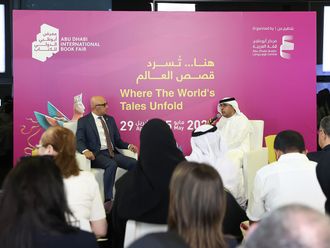Many workplace conflicts can be traced back to the great divide known as the Generation Gap. And it all begins with stereotypes, writes Jennifer Moore
The sight is a familiar one: the young rookie shows up for day one on the job, raring to go with his new MBA jargon and spiffy business casual wear. The veteran entrepreneurs pause, lower their reading glasses and examine him, thinking, 'Hmm... probably wants to revolutionise our company'.
The rookie, meanwhile, is wondering whether the dinosaurs in his midst even know how to turn on a PC.
It's a classic case of a phenomenon, which has, in recent years, become a hot topic in the business scene. It's the clash of ideals, education, and even culture, which stems not from different geographical or ethnic backgrounds, but from growing up in different eras.
Many workplace conflicts can be traced back to the great divide known as the Generation Gap.
It all begins with stereotypes. The young think they are dealing with cave men who are fossilised into their old-fashioned ways. The older think they have just hired a yearling with zero experience who, oddly, prefers to speak using abbreviations rather than words. And whereas these stereotypes are direly exaggerated, each might have an element of truth to it, as stereotypes often do.
Dr Stephanie Jones, associate professor of Business Administration at the American University in Dubai, lectures to her management class about the typical images of the "old" and "new", often younger, managers.
"As for the old manager, that's someone who is very respectful of hierarchy, keeps information to him – or herself, doesn't communicate ideas and strategies very broadly. He looks for everybody to be there all the time and only talks to his deputy, using the old chain of command," said Jones.
"Regarding the new, the idea is that he is often young, really into teamwork and sharing information, and is more hands-on."
Another part of the younger person stereotype, though, is that they are full of jargon but have no context or discipline. Yes, they may have new ideas, but are they tested, or are they just fashionable?
Jones says her students tend to see the "old" manager as similar to the older person stereotype, and the new as the sort-of "maverick", who goes on a first-name basis with everyone.
But perhaps the most obvious difference between the generations is their grasp on new technology. Today's workplace has an entire generation which has never known a world without computers, the Internet, and the letter "E" in front of everything from mail to shopping to business.
To the older generation, it can be intimidating, possibly even threatening. Also, the old might not care to learn the modern methods of the industry because they are planning on retiring soon anyway. Often, the "this-is-the-way-we've-always-done-it" attitude prevails, and can keep the company from expanding or staying in the race.
"Even in the UAE, there are entrepreneurs whose children, even their daughters, come back with a very good education, wanting to do very new things, like e-business. They are so technology-driven," explained Jones. "But the first generation of entrepreneurs, they have a totally different mindset. Some of them don't even know how to switch on a computer or give a proper presentation."
Changing language
The ever-changing business world is also reflected in its language. Tito Mathachan, a 29-year-old sales executive for the UAE-based Orient Tours, says the language has changed since he got started in the travel industry just five years ago.
"Immediately, those coming out of college, they come in with all this updated slang," he said. "During my time of education, we had our own type of slang. But already it's changed. Sometimes, I have to go to the extent of asking, 'What is this?' You can't use Victorian language, but if it's new, it needs to be appropriate," he said, adding that fancy talk is no substitute for hard work.
Jones, too, agrees there is a certain lingo which, more and more, men and women of business are picking up. "There's certainly something I would call 'MBA talk'," she says as she recalls a conversation she had with someone outside the current university scene. "Unfortunately, he was lost because I was using abbreviations that were not familiar to him," she said.
Abbreviations are indeed the norm in today's business education, and they are finding their way into the already-established office. The use of abbreviations can be frustrating for the more traditional associates, and can sometimes come across as arrogance on the part of the younger ones.
Due to the age gap, it's the natural tendency for the two groups to view one another as parents and children. The "parents" of the company have laid the foundation of the "family", and have encountered many a lesson in the process of doing so. They tend to think of the fresh faces, who are often times the same age as their own children, as lovable but in desperate need of hand-holding and the occasional discipline.
The "kids" in the business in return look upon their more mature counterparts as they would their parents: wise and respectable, with plenty of good advice, but quite conservative and undeniably out-dated.
One case in point: the issue of what to wear on the job. Strolling through some Fortune 500 companies' offices could easily trigger memories of going through one's parent's (or child's) wardrobe.
However, it's not usually so much a difference of en vogue verses fashion faux pas, but more a difference in how formal coming to work should be.
Ralph Lauren and Perry Ellis designers have released new lines of "business casual" wear, which is decidedly the dress of today's young entrepreneur generation. Many businesses now call one day a week "Dress-down" day, where employees wear something to the tune of casual trousers and a nice shirt or sweater.
However, there is a habit among the older generation to continue in the more traditional, formal way of dressing, that is, in the well-established suit and tie.
"There was a generation that never wore casual clothes. My dad wore a suit and tie every day. That's certainly a generation thing," recalled Jones.
What might seem like a trivial issue is actually a potential mess. Maintaining a professional image is imperative; what an individual wears to work says a lot about that person to colleagues, and more importantly, to clients.
And then there's the issue of "How casual is too casual?" The reaction of a client to a young associate showing up at a business luncheon in jeans is a scenario most entrepreneurs would rather not imagine.
Companies, just like the family, must constitute of a natural blend of old and young in order to thrive, and executives will no-doubt continue to build the office in such a structure. Each is brought into the group for specific reasons, and each has an irreplaceable role to play in today's industry.
The older generation of workers brings a plethora of experience to the atmosphere, and are generally more stable and realistic. But the young are also needed for their drive to apply what they have just learned, their new grasp on technology, and their ability to bring into the office a sprigh
Bridging the generation gap at work
The sight is a familiar one: the young rookie shows up for day one on the job, raring to go with his new MBA jargon and spiffy business casual wear.












